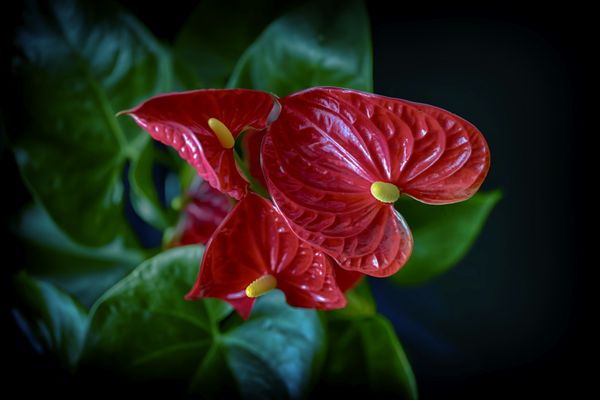Flamingo Flower Care Guide
How to grow and care for Flamingo Flower (Anthurium andraeanum)
Welcome to the delightful world of Anthurium andraeanum, commonly known as the Flamingo Flower. Renowned for its striking, waxy flowers in vibrant shades of red, pink, white, and even orange, this plant is a beloved choice for indoor gardeners. Not only does it add a splash of color to your home, but it also purifies the air, making it a charming and practical addition to your indoor oasis.

Disclosure: This content includes affiliate links, which means we may earn a commission if you click on a link and make a purchase. As an Amazon Associate, we earn from qualifying purchases. This comes at no extra cost to you and helps offset the cost of running Leafwise. Please read our disclaimer for more info.
Table of Contents
Care
Light
Anthurium andraeanum, also known as the Flamingo Flower, thrives in bright, indirect light. Too much direct sunlight can scorch its leaves, while too little light can lead to sparse flowering. A north or east-facing window is ideal for maintaining blooms and healthy growth.
Watering
Water your Anthurium when the top inch of soil feels dry. Ensure thorough watering, allowing excess water to drain from the pot. Avoid overwatering, as it can lead to root rot. Reduce watering during the winter when growth slows. Keep the soil slightly moist but never soggy.
Humidity & Temperature
Maintain temperatures between 70°F and 85°F (21°C and 29°C). Anthuriums thrive in high humidity (above 60%), which helps them maintain lush foliage and consistent flowering. Consider misting the leaves every 2-3 days during the growing season, placing the plant near a humidifier, or using a pebble tray filled with water.
Soil
Use a well-draining, organic-rich potting mix. A mix designed for orchids or a blend of peat moss, pine bark, and perlite works well to retain moisture without waterlogging the roots. Ensure the pot has proper drainage to avoid water buildup.
Fertilization
Feed your Anthurium every 2-4 weeks during the growing season (spring and summer) with a fertilizer high in phosphorus (to encourage blooming) or a balanced, water-soluble fertilizer diluted to half strength. Avoid over-fertilizing, as it can lead to salt buildup and damage the roots. Flush the soil periodically to prevent salt accumulation.
Maintenance
Pruning
Prune any yellow, brown, or dead leaves regularly to encourage new growth and maintain the plant’s aesthetic. Remove spent flowers to redirect energy toward new blooms.
Cleaning
Wipe the leaves with a damp cloth to remove dust and improve the plant’s ability to photosynthesize efficiently. Clean leaves also help prevent pests.
Repotting
Repot every 2-3 years or when the plant becomes root-bound. Use a slightly larger pot and fresh, well-draining soil.
Propagation
Anthuriums can be propagated through division or stem cuttings:
- Division – During repotting, gently separate a section of the plant with its roots attached and replant it in a pot with fresh soil.
- Stem Cuttings – Take a cutting with at least one node and place it in water or soil to root. Keep the cutting in a warm, humid environment with indirect light.
Common Issues
Yellowing Leaves
Cause: Overwatering, low light, or nutrient deficiencies.
- Solution: Ensure the soil has proper drainage and adjust watering. Move the plant to a location with bright, indirect light. Apply a balanced fertilizer if needed.
Brown Leaf Tips or Edges
Cause: Low humidity, mineral buildup from tap water, or over-fertilization.
- Solution: Increase humidity by misting or using a humidifier. Use distilled or filtered water to prevent mineral buildup. Flush the soil if over-fertilization is suspected.
Lack of Flowers
Cause: Insufficient light or improper fertilization.
- Solution: Move the plant to a brighter location with indirect light. Ensure it receives regular fertilizer high in phosphorus during the growing season.
Pests (Spider Mites, Mealybugs, Aphids)
Cause: Dry indoor conditions, poor airflow, and dusty leaves.
- Solution: Wipe the leaves with a mixture of water and mild soap. Apply neem oil or insecticidal soap weekly if pests persist. Improve humidity and airflow.
Root Rot
Cause: Overwatering and poor drainage.
- Solution: Remove the plant from its pot and inspect the roots. Trim any mushy or blackened roots and repot in fresh, well-draining soil. Adjust watering to prevent future issues.
Toxicity Warning
Anthurium plants are toxic to humans and pets due to the presence of calcium oxalate crystals. Ingestion can cause mouth irritation, drooling, and digestive discomfort. Keep the plant out of reach of children and pets, and wear gloves when handling if you have sensitive skin.
By following these care tips, your Anthurium andraeanum will reward you with its vibrant, long-lasting blooms and lush foliage, making it a stunning centerpiece in your indoor space.
